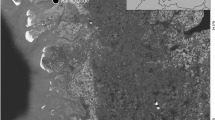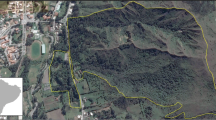Abstract
Alpine sites in the High Sudetes Mts. host—due to their history and special climatic conditions—unique assemblages of lepidopteran species. We used data from ten of these sites to study species richness of the lepidopteran fauna and to test the effect of site area, distance to the nearest site and connectivity. For this, we used cluster analyses, species–area relationship and the incidence function model, followed by canonical analysis to test the importance of individual factors. The list of species was compiled from available literature sources with regard to recent findings. Species richness depended significantly on all geographic factors—area, distance and connectivity. Large alpine sites were more species-rich than smaller ones and remote sites differed in species composition from the others. We conclude that any decrease of the area of these sites will drastically affect the unique lepidopteran assemblages living in the High Sudetes Mts.





Similar content being viewed by others
References
Arrhenius O (1921) Species and area. J Ecol 9:95–99
Benes J, Kuras T, Konvicka M (2000) Assemblages of mountainous day-active Lepidoptera in the Hruby Jesenik Mts., Czech Republic. Biol Bratislava 55:159–167
Boggs CL, Murphy DD (1997) Community composition in mountain ecosystems: climatic determinants of montane butterfly distributions. Glob Ecol Biogeogr 6:39–48
Buchar J, Ruzicka V (2002) Catalogue of spiders of the Czech Republic. Peres Pub, Praha
Cizek O, Bakesova A, Kuras T, Benes J, Konvicka M (2003) Vacant niche in alpine habitat: the case of an introduced population of the butterfly Erebia epiphron in the Krkonose Mountains. Acta Oecol 24:15–23. doi:10.1016/S1146-609X(02)00004-8
de Lattin G (1967) Grundriss der Zoogeographie [Zoogeography principles]. VEB Gustav Fisher Verlag, Jena
Demek J, Kopecky J (1998) Mt. Kralicky Sneznik (Czech Republic); landforms and problem of Pleistocen glaciation. Moravian Geogr Rep 6:18–37
Dennis RLH (1993) Butterflies and climate change. Manchester Univ. Press, Manchester
Dennis RLH, Shreeve TG (1997) Diversity of butterflies on British islands: ecological influences underlying the roles of area, isolation and the size of the faunal source. Biol J Linn Soc 60:257–275. doi:10.1111/j.1095-8312.1997.tb01495.x
Dennis RLH, Shreeve TG, Williams WR (1995) Taxonomic differentiation in species richness gradients among European butterflies (Papilionoidea, Hesperioidea): contribution of macroevolutionary dynamics. Ecography 18:27–40. doi:10.1111/j.1600-0587.1995.tb00116.x
Dennis RLH, Williams WR, Shreeve TG (1998) Faunal structures among European butterflies: evolutionary implications of bias for geography, endemism and taxonomic affiliation. Ecography 21:181–203. doi:10.1111/j.1600-0587.1998.tb00672.x
Dennis RLH, Donato B, Sparks TH, Pollard E (2000) Ecological correlates of island incidence and geographical range among British butterflies. Biodivers Conserv 9:343–359. doi:10.1023/A:1008924329854
Dennis RLH, Olivier A, Coutsis JG, Shreeve TG (2001) Butterflies on islands in the Aegean archipelago: predicting numbers of species and incidence of species using geographical variables. Entomol Gaz 52:3–39
Devy MS, Ganesh T, Davidar P (1998) Patterns of butterfly distribution in the Andaman islands: implications for conservation. Acta Oecol 19:527–534. doi:10.1016/S1146-609X(99)80007-1
Dyck HV, Matthysen E (1999) Habitat fragmentation and insect flight: a changing ‘design’ in a changing landscape? Trends Ecol Evol 14:172–174. doi:10.1016/S0169-5347(99)01610-9
Everitt B, Hothorn T (2006) A handbook of statistical analyses using R. Chapman and Hall/CRC, London
Fleishman E, Austin GT, Weiss AD (1998) An empirical test of Raport’s rule: Elevatonal gradients in mountane butterfly communities. Ecology 79:2482–2493. doi:http://dx.doi.org/10.1890/0012-9658(1998)079[2482:AETORS]2.0.CO;2
Grabherr G, Gottfried M, Gruber A, Pauli H (1995) Patterns and current changes in alpine plant diversity. In: Chapin FS III, Körner C (eds) Arctic and alpine biodiversity: patterns, causes and ecosystem consequences. Springer, Berlin, pp 167–181
Gutierrez D (1997) Importance of historical factors on species richness and composition of butterfly assemblages (Lepidoptera: Rhopalocera) in northern Iberian mountain range. J Biogeogr 24:77–88. doi:10.1111/j.1365-2699.1997.tb00052.x
Gutierrez D, Menendez R (1998) Stability of butterfly assemblages in relation to the level of numerical resolution and altitude. Biodivers Conserv 7:967–979. doi:10.1023/A:1008885522377
Hanski I, Gaggiotti OE (eds) (2004) Ecology, genetics, and evolution of metapopulations. Elsevier Academic Press, San Diego
Hanski I, Moilanen A, Pakkala T, Kuussaari M (1996) The quantitative incidence function model and persistence of an endangered butterfly metapopulation. Conserv Biol 10:578–590. doi:10.1046/j.1523-1739.1996.10020578.x
Hanski I, Alho J, Moilanen A (2000) Estimating the parameters of migration and survival for individuals in metapopulations. Ecology 81:239–251. doi:http://dx.doi.org/10.1890/0012-9658(2000)081[0239:ETPOSA]2.0.CO;2
Hewitt GM (1999) Post-glacial re-colonization of European biota. Biol J Linn Soc 68:87–112. doi:10.1111/j.1095-8312.1999.tb01160.x
Isaac JL, Williams SE (2007) Climate change and extinctions. In: Levin S (ed) Encyclopaedia of biodiversity. Elsevier Press
Jahn A, Kozlowski S, Pulina M (1997) Masyw Snieznika: Zmiany w srodowisku przyrodniczym [Massif of Kralicky Sneznik: Changes in natural environment]. Polska agencija ekologiczna, Warszawa
Jenik J (1961) Alpinska vegetace Krkonos, Kralickeho Snezniku a Hrubeho Jeseniku. Teorie anemo-orografickych ekosystemu [Alpine vegetation of the Krkonose Mts., Kralicky Sneznik and Hruby Jesenik Mts. Theory of anemo-orographical ecosystems]. Nakl CSAV, Praha
Jenik J (1998) Biodiversity of the Hercynian Mountains in central Europe. Pirineos 151(152):83–99
Jenik J, Hampel R (1992) Die Waldfreien Kammlagen des Altvatergebirges: Geschichte und Ökologie [Treeless areas in the Hruby Jesenik Mts.: History and Ecology]. Mährisch-Schlesischer Sudetengebirgsverein, Kirchheim/Teck
Jenik J, Stursa J (2003) Vegetation of the Giant Mountains, Central Europe. In: Nagy L, Grabherr G, Körner C, Thompson DBA (eds) Alpine biodiversity in Europe (ecological studies). Springer, Berlin, pp 47–51
Keil S, Gu HN, Dorn S (2001) Response of Cydia pomonella to selection on mobility: laboratory evaluation and field verification. Ecol Entomol 26:495–501. doi:10.1046/j.1365-2311.2001.00346.x
Kindlmann P, Burel F (2008) Connectivity measures: a review. Landsc Ecol 23:879–890. doi:10.1007/s10980-008-9245-4
Klimes L, Klimesova J (1991) Alpine tundra in the Hruby Jesenik Mts., the Sudeten, and its tentative development in the 20th century. Preslia 63:245–268
Krahulec F (1990) Alpine vegetation of the Kralicky Sneznik Mts. (The Sudeten Mts.). Preslia 62:307–322
Krampl F (1992) Boreal macro-moths in Central Europe (Czechoslovakia) and their eco-geographical characteristics (Lepidoptera: Geometridae, Noctuidae, Notodontidae). Acta Entomol Bohemos 89:237–262
Kuras T, Helova S (2002) Relict occurrence of the leaf-roller Sparganothis rubicundana in Central Europe (Lepidoptera, Tortricidae). Cas Slez Muz Opava (A) 51:199–204
Kuras T, Benes J, Konvicka M (2000) Differing habitat affinities of four Erebia species (Lepidoptera: Nymphalidae, Satyrinae) in the Hruby Jesenik Mts, Czech Republic. Biol Bratislava 55(2):169–175
Kuras T, Konvicka M, Benes J, Cizek O (2001) Erebia sudetica and Erebia epiphron (Lepidoptera: Nymphalidae, Satyrinae) in the Czech Republic: review of present and past distribution, conservation implications. Cas Slez Muz Opava (A) 50:57–81
Kuras T, Benes J, Fric Z, Konvicka M (2003) Dispersal patterns of endemic alpine butterflies with contrasting population structures: Erebia epiphron and E. sudetica. Popul Ecol 45:115–123. doi:10.1007/s10144-003-0144-x
Kuras T, Sitek J, Liska J, Mazalova M, Cerna K (2009) Motyli (Lepidoptera) narodni prirodni rezervace Praded (CHKO Jeseníky): implikace poznatku v ochrane uzemi [Lepidoptera of the Praded National Nature Reserve (Jeseniky Protected Landscape Area): conservation implications]. Cas Slez Muz Opava (A) 58:250–288
Lastuvka Z, Liska J (2005) Seznam motylu Ceske republiky (Insecta: Lepidoptera) [Checklist of Lepidoptera of the Czech Republic (Insecta: Lepidoptera)]. http://www.lepidoptera.wz.cz/Lepidoptera.pdf. Accessed 30 Jan 2009
Liska J (1997) Motyli fauna Upskeho a Cernohorskeho raseliniste v Krkonosich [Lepidoptera of the Upske and Cernohorske raseliniste bogs in the Krkonose Mts.]. In: Geoekologiczne problemy Karkonoszy. Materialy z sesji naukowej w Przesiece 15.-18. X. 1997, Tom II.—Poznan, Wydawnictwo Acarus 1998, pp 93–96
Liska J (2000) Pokus o srovnani motyli fauny subalpinskych poloh Vysokych Sudet [Attempt at comparing lepidopteran fauna of subalpine areas of the High Sudetes]. Opera Corcontica 37:286–290
Liska J, Skyva J (1997) Historical and recent occurrence of Lepidoptera in mountains sites of the Giant Mountains (Czech Republic). Biol Bratislava 52:163–165
MacArthur RH, Wilson EO (1967) The theory of island biogeography. Princeton Univ. Press, Princeton
Moilanen A, Nieminen M (2002) Simple connectivity measures in spatial ecology. Ecology 83:1131–1145. doi:http://dx.doi.org/10.1890/0012-9658(2002)083[1131:SCMISE]2.0.CO;2
Nagy L, Grabherr G, Körner C, Thompson DBA (eds) (2003) Alpine biodiversity in Europe (ecological studies). Springer, Berlin
Nieminen M (1996) Migration of moth species in a network of small islands. Oecologia 108:643–651
Oksanen J et al (2011) Vegan: Community Ecology Package. R package version 1.17-8. http://CRAN.R-project.org/package=vegan. Accessed 20 Feb 2011
Ormsby T, Napoleon EJ, Breslin P, Frunzi N (1998) Getting to know ArcView GIS. Esri Press, Redlands
Patocka J, Kulfan J (2009) Motyle Slovenska (bionomia a ekologia) [Lepidoptera of Slovakia (bionomics and ecology)]. Vydavatelstvo VEDA, Slovakia
Qureshi JA, Buschman LL, Throne JE, Ramaswamy SB (2005) Adult dispersal of Ostrinia nubilalis Hubner (Lepidoptera: Crambidae) and its implications for resistance management in Bt-maize. J Appl Entomol 129:281–292. doi:10.1111/j.1439-0418.2005.00966.x
R Development Core Team (2009) R: a language and environment for statistical computing. R Foundation for Statistical Computing, Vienna
Real R, Vargas JM (1996) The probabilistic basis of Jaccard’s index of similarity. Syst Biol 45:380–385. doi:10.1093/sysbio/45.3.380
Rickleffs RE, Lovette IJ (1999) The role of island area per se and habitat diversity in the species–area relationships of four Lesser Antillean faunal groups. J Anim Ecol 68:1142–1160. doi:10.1046/j.1365-2656.1999.00358.x
Ricklefs RE, Schluter D (eds) (1993) Species diversity in ecological communities: historical and geographical perspectives. University of Chicago Press, Chicago
Rosenzweig ML (1995) Species diversity in space and time. Cambridge Univ. Press, Cambridge
Ryan BF, Joiner BL, Cryer JD (2004) MINITAB Handbook: Updated for Release 14. Duxbury Press, Duxbury
Schmitt T, Cizek O, Konvicka M (2005) Genetics of a butterfly relocation: large, small and introduced populations of the mountain endemic Erebia epiphron silesiana. Biol Conserv 123:11–18. doi:10.1016/j.biocon.2004.09.018
Shimodaira H (2002) An approximately unbiased test of phylogenetic tree selection. Syst Biol 51:492–508. doi:10.1080/10635150290069913
Sitzia T, Semenzato P, Trentanovi G (2010) Natural reforestation is changing spatial patterns of rural mountain and hill landscapes: a global overview. Forest Ecol Manag 259:1354–1362. doi:10.1016/j.foreco.2010.01.048
Soffner J (1960) Schmetterlinge aus dem Riesengebirge [Lepidoptera of the Giant Mts.]. Zeitschrift der Wiener Entomologischen Gesellschaft 45:70–91
Soukupova L, Kocianova M, Jenik J, Sekyra J (eds) (1995) Arctic—alpine tundra in the Krkonose, the Sudetes. Opera Corcontica 32:5–88
Strathdee AT, Bale JS (1998) Life on the edge: insect ecology in Arctic environments. Annu Rev Entomol 43:85–106. doi:10.1146/annurev.ento.43.1.85
Treml V, Banas M (2000) Alpine timberline in the High Sudetes. Acta Univ Carol Geogr 35:83–99
Ulrich W, Buszko J (2003) Species-area relationships of butterflies in Europe and species richness forecasting. Ecography 26:365–373
Ulrich W, Buszko J (2005) Detecting biodiversity hotspots using species–area and endemics–area relationships: the case of butterflies. Biodivers Conserv 14:1977–1988. doi:10.1007/s10531-004-2526-6
Varga Z, Schmitt T (2008) Types of oreal and oreotundral disjunctions in the western Palearctic. Biol J Linn Soc 93:415–430. doi:10.1111/j.1095-8312.2007.00934.x
Whittaker RJ (1999) Island biogeography. Ecology, evolution, and conservation. Oxford Univ. Press, Oxford
Acknowledgments
We thank Vaclav Treml for providing geographical data regarding timberline, site locations and situation map of the High Sudetes Mts. (Fig. 1). We are also obliged to Jan Liska for classifying species from the Krkonose-West and Krkonose-East and Tony Dixon for English correction. This research was funded by the Ministry of Environment of the Czech Republic (projects VaV SM/6/70/05 and VaV/620/15/03), grant No. IG UP 913104041/31 and by the MSMT grants CzechGlobe—Reg.No. CZ.1.05/1.1.00/02.0073, and LC06073.
Author information
Authors and Affiliations
Corresponding author
Rights and permissions
About this article
Cite this article
Bila, K., Kuras, T., Sipos, J. et al. Lepidopteran species richness of alpine sites in the High Sudetes Mts.: effect of area and isolation. J Insect Conserv 17, 257–267 (2013). https://doi.org/10.1007/s10841-012-9504-1
Received:
Accepted:
Published:
Issue Date:
DOI: https://doi.org/10.1007/s10841-012-9504-1




